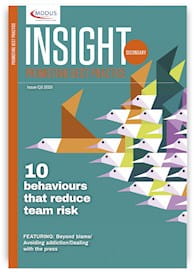 AS WE begin to consider a post-COVID world, there is a risk that misuse of prescribed opioid and analgesic painkillers, and indeed other potentially addictive prescribed medication, will have increased during lockdown.
AS WE begin to consider a post-COVID world, there is a risk that misuse of prescribed opioid and analgesic painkillers, and indeed other potentially addictive prescribed medication, will have increased during lockdown.
We know these drugs are often misused to cope with stress, and we have just been through a period where ‘business as usual’, particularly in terms of appointments and regular reviews, has been severely disrupted. We also know that prescribing levels for these drugs tend to be higher in areas of greater deprivation and among communities likely to be most impacted economically by the coming recession. We could be facing a perfect storm of risk.
As director of innovation and service delivery at Agencia, I’ve worked closely with healthcare professionals on a number of projects related to managing alcohol and drug misuse. Agencia operates in partnership with government to deliver new policies and to help providers and commissioners improve frontline services to tackle opioid dependence.
Our experience is that patients who leave hospital with an ongoing prescription to manage their pain often remain on that prescription and may have doses increased over a period of time. This is backed up by research. A recent evidence review by Public Health England cited a study from Canada which found that older adult patients receiving an opioid prescription within seven days of surgery were 44 per cent more likely to become long-term opioid users within one year compared with those who received no such prescription.
In this article I want to share my experience in designing and running ReWire, a project in North Lincolnshire which worked with patients at high risk of opioid dependence. Some of the insights gained are highly relevant to secondary care.
The ReWire approach
Research had identified opioid analgesic dependence (OAD) as a significant health risk to the population. Agencia worked with North Lincolnshire Council and a number of GP practices to identify the scale of the problem and develop workable and scalable solutions – and from this pilot the ReWire service evolved. It sought to address the issue through analysis of prescribing data, patient identification via an opioid risk assessment tool (ORAT), and provision of a service which combines a non-medical prescribing pharmacist and an experienced psychosocial worker to support individuals who wish to address their OAD.
We ran ORAT across a selection of practices which reflected the demographics of North Lincolnshire, and we filtered the results to include only under 55s and those identified as potentially most at risk. Of those engaged in treatment, 44 per cent were female. The results were assessed consistently by an experienced pharmacist with clinical support from GPs. Patients identified as being potentially at risk were then invited by GPs to attend for a medication review, with immediate support available from an experienced psychosocial worker who could offer a six-session programme which covered interventions from brief advice through to full opioid substitution therapy (OST).
We focused on practical solutions, supported by lots of informal awareness-raising – leaflet drops and training the GP admin and reception teams on how to work with a group of patients who were nervous about being called in for a review, and managing those anxieties sympathetically. The aim was to inform first, and then engage. Our engagement, treatment and session models recognised this patient group would not feel comfortable in a ‘drug service’.
The results were surprising. A group of patients who were seen as potentially very resistant to change proved to be very open to new approaches to pain management and often expressed private concern about the amount of medication they were taking and its impact on their quality of life. Many changed their prescribing regimens, with 20 per cent of patients stopping repeat prescribing on receipt of a first letter. Even those who required OST usually swiftly became drug-free.
Many of the patients we engaged had a series of longer conversations with our clinicians, pharmacists and psychosocial workers and we were able to establish some fascinating insights into how and why they started using opioid painkillers. Some left hospital with ongoing prescriptions to manage pain and were then maintained on those prescriptions, often with increased doses over a period of time. Many were not aware of the long-term risks of opioid prescribing and they also had little knowledge of alternative ways of managing pain.
Again, by spending time with them discussing how they dealt with pain and introducing them to alternative methods of coping (such as using a pain management toolkit), we were often able to improve outcomes. Another factor in long-term use of painkillers was that many mistook relatively mild withdrawal symptoms for a return of their pain and, after a short session on how to manage these withdrawals, were able to cope far better and often taper their prescriptions. Patients and their families genuinely appreciated the intervention.
What helps?
There is no easy solution to prescribed opioid addiction. People often need pain relief, particularly in hospital and often for a period of time after their discharge. There are a number of techniques and pro-active practices that could make a significant difference:
- Discuss with patients their ‘medication exit strategy’ at the earliest opportunity. This should include how and when they should stop taking medication and any support available in that process.
- Investigate use of over-the-counter medication if that could be an issue. We had one patient who had attended at least three outpatient appointments and a couple of emergency admissions for gastric problems without mentioning that he was taking significant amounts of co-codamol and had been for years. When challenged, he said: “No one asked me about that”.
- Point out the long-term risks and also make clear what short-term withdrawal feels like and some coping strategies.
- Produce easily accessible information leaflets to inform patients. The information that comes with the medication is rarely that easy to understand and is almost always in very small print.
- Risk-assess the patient history where possible: any previous addiction should raise a warning flag. It may not change prescribing practice but should highlight the need for a clear timeframe to review prescribing options.
- Review pathways between secondary care, general practice and pain management clinics.
Spotting potential addiction
None of this is easy, and in a highly-pressured environment, finding time can be a major problem. But in our experience, a small amount of prevention can have a huge and positive impact on patient outcomes.
I have also run a programme at a number of hospitals called Making Every Contact Count (MECC). We had great results through finding champions (often nurses or healthcare assistants) to take the lead in designing prevention and information services locally. I believe that this model could be highly effective without requiring too much in the way of service redesign or resources.
Conclusion
ReWire was created to use data intelligently to target those most at risk of addiction and focus on prevention. We’ve found it is possible to significantly reduce prescribing costs and improve patient outcomes. It has also given us real insight into patients struggling with painkiller use. Prescribing decisions made in secondary care can have long-term unintended consequences for patients. Preventing negative outcomes requires excellent communication, strategic awareness and resources, but the rewards for both patients and the NHS are potentially huge.
Graeme Dixon is director of service and innovation at Agencia, where he has run a number of services identifying and managing opioid addiction in partnership with GP practices
Find out more about Agencia and ReWire at www.agencialtd.com. Follow them on Twitter @agencia_ltd, and @ReWirePKService
This page was correct at the time of publication. Any guidance is intended as general guidance for members only. If you are a member and need specific advice relating to your own circumstances, please contact one of our advisers.
Read more from this issue of Insight Secondary

Save this article
Save this article to a list of favourite articles which members can access in their account.
Save to library

